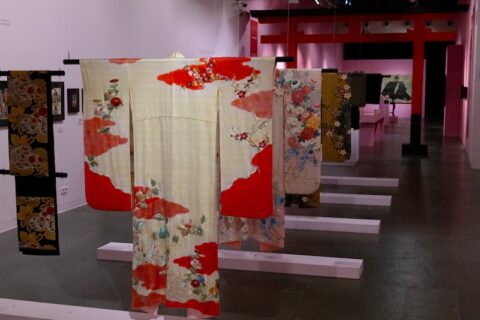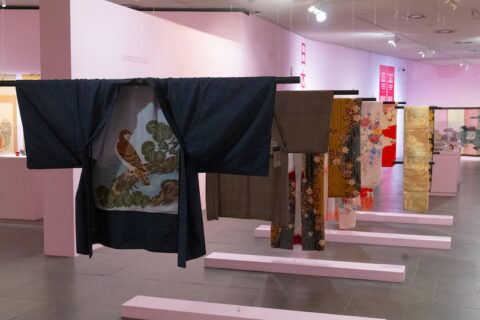MuVIM
The Mirror of Beauty: Japanese Art from the 16th to the 20th Century
Temporary Exhibition (Extended until October 12, 2025)
10 y Guillen de Castro 8 | 46001, Valencia
The temporary exhibition in the downstairs exhibit hall (Sala Alfons Roig) is an unexpected joy. Sometimes the exhibit rooms at the MuVIM feel a bit small but one is never disappointed by the work of the curators to pack a small space with expansive exhibits featuring far reaching art and ideas.

The exhibit is filled with an eclectic mix ranging from classic porcelain to kimonos. This includes “engravings, sculptures, masks, illustrated books, ceramics, fabrics, paintings, coins, calligraphic works, stamps, screens, dolls and various objects of everyday use” (from the MuVim Web page).
Even though the room is small the sheer volume of interesting artifacts is captivating, each section focusing on one of the topics. The kimonos and stamps alone offer a lovely journey into the most intricate of expressive art.

The great feature of the MuVIM is that this exhibit is free. You can drop in for a bit, see an exhibition (or even part of one) and come back for more later. The space is so lovely — a cool, calm artistic oasis in the center of Valencia.
Below is a translation of the information from the Web site:
“This exhibition invites us to a journey into the heart of beauty, a basic characteristic of Japanese art and, in all probability, the most easily recognizable trait of those who define it. Through a large and heterogeneous group of pieces that include engravings, sculptures, masks, illustrated books, ceramics, fabrics, paintings, coins, calligraphic works, stamps, screens, dolls and various objects of everyday use, the exhibition proposes a tour of the various manifestations of this aesthetics that, in the case of Japan, is indissolubly linked to nature, understanding it as a whole of which also the human being is part. Hence the huge and robust trunk — “natural beauty” from which the different branches of this allegorical tree emerge that sinks its roots in the dialectic between realism and stylization, the two opposing poles on which gravitate harmoniously the representations of nature presented here.
The branches to which we alluded are three: “Atmospheric phenomena”, “landscape” and “elements” —minerals, plants, animals and humans— that integrate it, all of them embodied in a wide variety of material supports. Of the last of these branches, “the elements”, and, specifically, of the human element, treated on many occasions as a mere ornament, a new branch is born that we have called “artificial beauty” —in the sense of “made or produced by the hand of man”— and that, nourish “the human landscape”; “abstract beauty”, exemplified by theater and calligraphy; and “gallant beauty”, which accommodates very different manifestations, but whose common denominator is the ritual character mediated by the gesture, concise, delicate and beautiful in itself. Among these events, the exhibition highlights the celebration of religious and civil events, the practice of arts such as flower arrangement and tea ceremony or family and social hobbies such as the preparation of Hina Matsuri, card games and the contemplation of nature, which speaks of a “seasonal and ephemeral beauty” and brings us back to the starting point, to the great trunk from which all branches have emerged: “Natural beauty”.
Precisely in the branches of this metaphorical tree into which the exhibition space has become, the last four types of beauty that the exhibition offers us will flourish: “The beauty of simplicity, of the ajado and of the imperfect”; “The invisible beauty”; “the random beauty”, materialized in the “found objects”; and “the beauty of the symbol”, which transcends representation.”

